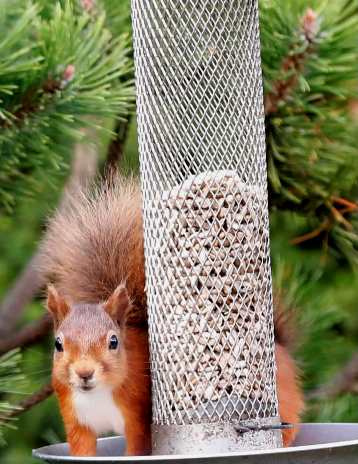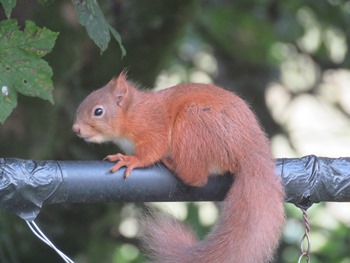The Sedbergh Red Squirrel Group

The Threat Posed by Greys
 By Karen and Steve Hopps
By Karen and Steve Hopps
(A version of this article was first published in the Sedbergh Lookaround on 1st August 2024.)
Earlier this year, the Sedbergh group received a report of a red squirrel with the Parapox virus. Carried by grey squirrels, the virus is deadly to our native reds. Only one case has been found so far, but there may be more.
It is hoped that, in time, the red squirrel will develop resistance to the virus, but at the moment the disease is a very serious threat to red squirrels across Cumbria. Please stay alert and report any reds or greys you have concerns about.
To preserve red squirrels, they must be kept apart from grey squirrels, as all of the evidence shows that the two species are unable to co–exist under normal circumstances. Once greys arrive, sooner or later, the reds will disappear.
Greys are twice the size of reds, live at much higher densities and are much more robust. Critically, greys are more prolific breeders, producing larger numbers of young which disperse to colonise new areas. They are able to outcompete reds by consuming and monopolising natural food sources at key times of the year before the reds are able to get to them. Greys also raid food caches that reds have buried. This failure to obtain enough food means that female red squirrels often emerge from winter in poor condition, and so breed less successfully.
So, although sightings of reds have been numerous, their population remains fragile, and we must keep up our vigilance in relation to non–native greys. Red squirrels are very elusive and spend much of their time in the tree canopy. Look out for scratch marks on bark and chewed pine cones that look like chewed apple cores. Listen out for their "chuk chuk" calls which are a vocalisation they often use.

A number of promising new developments are in the pipeline, which may help in the future. One is fertility control for greys, funded by the UK Squirrel Accord. Field trials are taking place over the next few years. The other fascinating issue is the slow and gradual recolonisation of the pine marten, a native predator. Research shows they have a beneficial effect on red squirrel populations. Unlike grey squirrels, reds have evolved alongside the predatory pine martens, and therefore know how to evade them.
Sedbergh is a "buffer zone". Along with the Northern Red Squirrels Group, we are working hard to set up a new local group in the Kirkby Lonsdale area to manage the greys and prevent them from coming our way.
Many large estates, land managers and individuals have been working hard to control the greys. Without their dedication and persistence, it is highly likely that we would already have lost red squirrels in Cumbria. A huge "Thank You" to all of you. However modest or large the part you play, it is making a difference!
Karen & Steve Hopps, August 2024